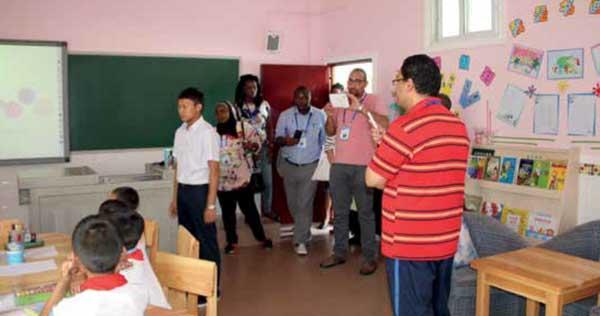No One Left Behind
By Ge Lijun


Every morning,fifth-grade schoolgirl Liu Lu goes to school with a smile on her face. But today little Liu and her classmates are even more excited, as they are looking forward to their favorite subject: art class. They will be taught for the first time how to use clay to create their own artworks. Liu has chosen to make a clay baby crocodile.
Liu is a student at Chengzhuang Primary School, a school suffering from a severe lack of resources. Located in Lankao County in central Chinas Henan Province, the school has a total of 150 students, but only nine teachers. But thanks to online education, students now have the chance to attend art classes despite the lack of funds and teaching staff.
In May, Liu and her classmates started taking creative design classes given by Shanghai-based teacher Gong Fei, of the Shanghai Chagall Art Education. This was made possible by CCtalk, an online live teaching software produced by Hujiang, one of Chinas major online education companies. “The creativity and imagination showed by the students really surprised me. After all, they had never taken art classes before,” Gong told China Central Television.
In the past, due to the few number of teachers, students in Chengzhuang Primary School were only able to attend math and Chinese classes. However, CCtalk has opened a wide range of new subjects to students, such as English, music, science and arts. The screen which hangs in front of the blackboard has enriched students knowledge and expanded their horizons by connecting them with teachers nationwide, and even worldwide.
Chengzhuangs success with online education is only but one example of Hujiangs Hujia Project, which was launched in 2015 with the purpose of updating traditional educational methods with new technologies. By enabling the sharing of resources, the project makes it possible for students in rural schools to enjoy high-quality education in an easier, fairer and happier way.
According to Dai Minghong, who is in charge of promoting the Hujia Project, rural schools like Chengzhuang Primary School can use the platform to gain access to high-quality education free of charge, as the costs are offset by revenue from Hujiangs other paid services. The Hujia Project also benefits from the support of several Chinese nongovernmental organizations.
Sharing resources
With the rapid urbanization of China in the past 20 years, the government has carried out a policy of combining rural schools with an aim of pooling teaching resources, which led to a 70-percent decrease in the number of village schools. Implementation of this policy stopped in 2012, but the remaining rural schools still face problems such as insufficient teachers and lack of development prospects.
In Guangyuan City of Sichuan Province, 16 small village schools, with each having less than 200 students, decided to join forces by combining their scattered teaching resources, in order to make sure students can enjoy high-quality education. The project started in 2014.
But their efforts failed to help students enjoy more teaching resources in Guangyuan until the emergence of online education. On December 13, 2015, Hujia Project decided to step in and provides Guangyuans small village schools with more teaching resources through its online platform.
Since March 7, 2016, by making use of the CCtalk live teaching software, students in Guangyuan rural schools have been able to attend online art classes from teachers thousands of miles away. Online teaching has significantly alleviated the problem of lack of local teachers and has aroused childrens interest in arts.
“It [Hujia Project] provides a platform for sharing high-quality educational resources which better match demand with supply. On the demand side, China has over 140.000 small rural schools lacking proper educational resources; on the supply side, China has a large number of educational NGOs, public welfare education institutions and enthusiastic volunteers who can provide professional and qualified educational resources. Hujiang connects the two sides,” said Wu Hong, Chief Education Officer of Hujiang and also manager of Hujia Project.
Power of the seed
Wu describes the influence of the Hujia Project in rural schools as “the power of the seed.” “We plant seeds in rural schools which then bring hope to people there. Parents begin to trust in rural schools and they agree to let their children receive education without having to leave their village,” Wu said. Until now, Hujia Project has allowed more than 100,000 students from over 500 schools in 20 provinces to enjoy an equally convenient access to educational resources. In order to provide rural children with better and more diverse curriculum, Hujia Project has entered in cooperation with highly qualified teaching institutions, including the 21st Century Education Research Institute and Shanghai International Studies University. “Many of rural students are ‘left-behind children whose parents work in urban areas. Hujia Project opens a door for them to acquire knowledge and discover the world,” Wu said.
Tremendous potential
On July 27, 2016, the General Offices of the Central Committee of the Communist Party of China and the State Council jointly issued a guideline for national information and communication technology development to further narrow the educational gap between urban and rural areas and between different regions, and to guarantee access to education for vulnerable groups through developing online education. The guideline also focused on increasing the Internet coverage in rural areas.
“The Internet has tremendous potential. Better than donating money and materials through charity, online education has the potential to truly meet the needs of rural schools in a low-cost, high-efficiency and largescale way, and make educational equality a reality,” Wu said.
“By the end of 2016, Hujia Project is expected to cover all areas of the country, providing high-quality teaching resources and Internet-based teachers training to rural schools equipped with the Internet.” Wu told ChinAfrica. Wu expects that in the next year, the project will cover 1 million students and hundreds of thousands of teachers, laying the foundations for a new cross-regional, Internedbased and cooperative way of teaching.

